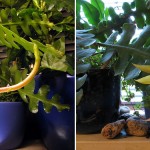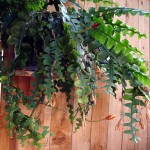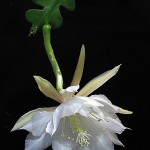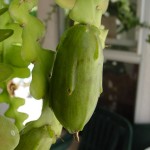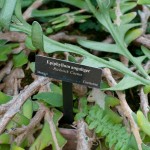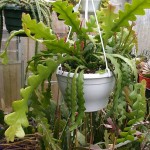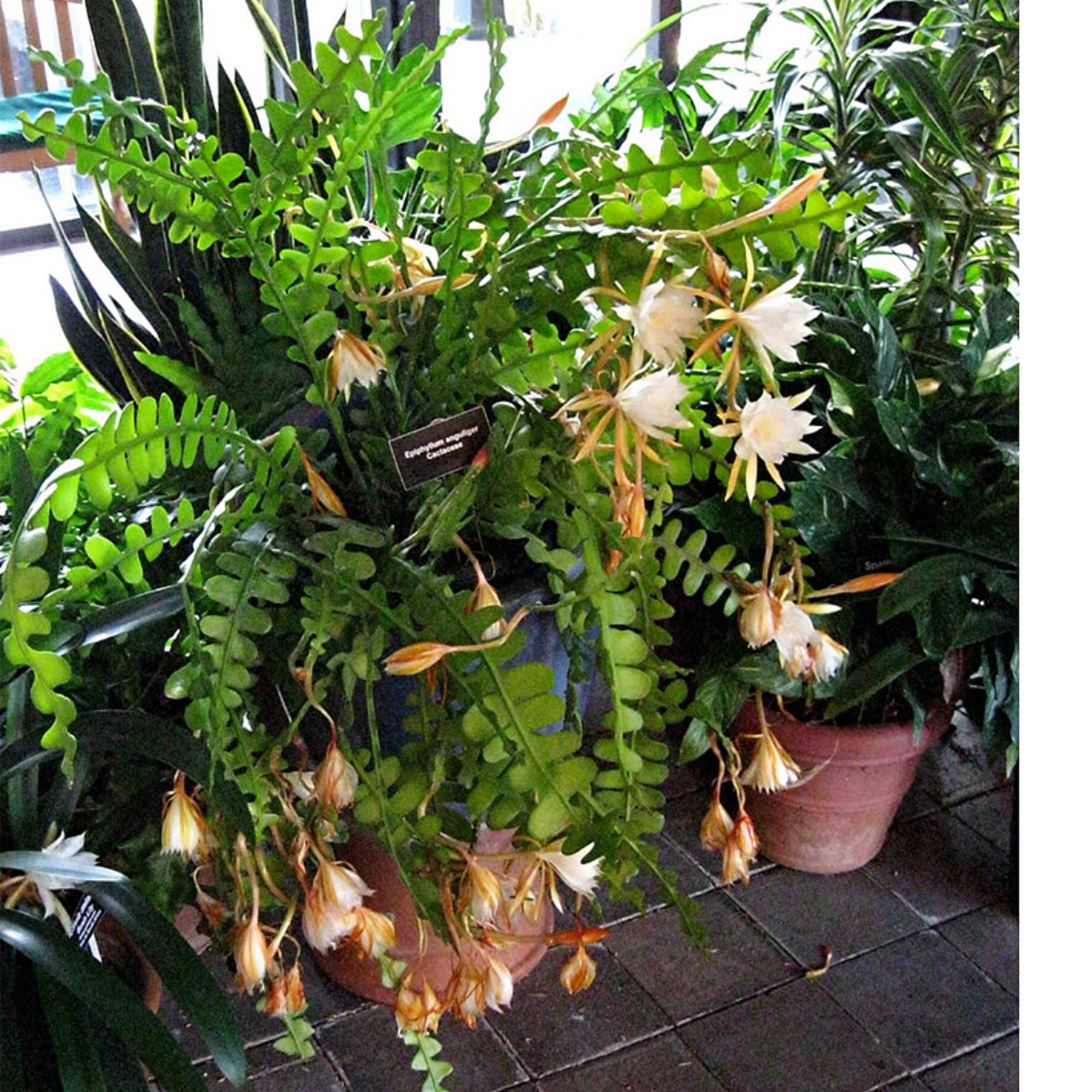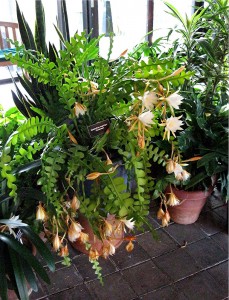Family: Cactaceae
Synonymous: Phyllocactus anguliger
Phyllocactus serratus
Phyllocactus angularis
Phyllocactus darrahii
Epiphyllum darrahii
Epiphyllum beahmii
Epiphyllum gertrudianum
Epiphyllum anguliger var. darrahii
Epiphyllum anguliger var. pillocarpa
Epiphyllum anguliger var. pulocarpa
Distribution and habitat: Epiphyllum anguliger is an epiphytic cactus species in evergreen oak forests. It is endemic to Mexico, where it is distributed in the States of Guerrero, Jalisco, Nayarit and Oaxaca at elevations of 1100 to 1800m (3600-5900 feet). Most grow in trees where they tuck their roots into pockets of decaying vegetable matter which settle into nooks and crannies of tree branches. They share their habitat with orchids, bromeliads, ferns and mosses. Their tropical environment provides them with lots of warmth and high humidity and most important... shading from full sun.
Description: Stems profusely branched, primary stems terete at base, often woody, apical part and secondary stems flat and rather succulent, 2030cm (8-12 inch) long, 35cm (1-2 inch) wide, deeply lobed, often to near midrib, the lobes rectangular to obtuse or rounded; areoles small nude or with 1-2 white bristles; epidermis green, smooth. Flowers 620cm (2-8 inch) long, 67cm (2-3 inch) wide, nocturnal, strongly sweet-scented; pericarpel with podarium; receptacle 816cm (3-6 inch) long, 4mm thick, pale yellow, greenish or pinkish, bracteoles few, minute, linear and green, adpressed; outer tepals 10, linear to linear-lanceolate, acute, spreading or reflexed, 45cm (2 inch) long, lemon yellow to brownish yellow; inner tepals lanceolate to ovate, acute or acuminate, white, sometimes toothed, as long as outer tepals; stamens in two rows, white, erect to subdeclinate, nearly as long as tepals; style longer than inner tepals, white; stigma lobes 8-11, linear. Fruit ovoid, brownish, greenish or yellowish, 34cm (1.5 inch) thick.
Epiphyllum anguliger is a true species and the leaf-like stems are shorter than most, with deep broad notches, giving the plant a very fishbone-like appearance. Flowering generally occur in late summer or fall. Up to six flowers may open at once and each last about a day.
Epiphyllum anguliger is a very variable species but rather distinct and recognition of sub-specific taxa seems unnecessary.
Houseplant care: The species is commonly grown as an ornamental for its beautiful, fragrant flowers in the fall. Epiphyllum anguliger is an easily cultivated, fast growing epiphyte.
Light: Give Epiphyllum anguliger medium light. If possible, keep them in a shady spot outdoors in summer.
Temperatures: These plants require warmth with high humidity. They should be kept at 1625C (6177F), it may drop to 1015C (5059F) for shorter periods. Mist spray them daily and stand the pots on trays or saucers of moist pebbles.
Watering: During spring and summer water plentifully, keeping the potting mixture thoroughly moist . Give plants a brief rest at the end of each flowering period by watering only enough during the next two or three weeks to prevent the potting mixture from drying out. At all other times water moderately, allowing the top centimetre (0.4 inch) or so of the potting mixture dry out completely between waterings.
Epiphyllum anguliger stems do not signal a lack of water by shrivelling as some cacti do. Cuttings of stems left in a dry place have been known to root perfectly well after as long as a year without being potted up.
Feeding: After flower buds start to form, apply a tomato-type fertiliser every two weeks. Stop feeding when most buds are open.
Potting and repotting: Use a potting mixture composed of one part of coarse sand and perlite to three of peat-based mixture. Move the plants into slightly larger pots every spring until they reach the 13 or 15cm (5-6 inch) pot size. Thereafter, simply shake off the old potting mixture from the roots and replace plants in their pots, which have been cleaned. Add fresh potting mixture as necessary. Epiphyllum anguliger which grow taller than 20cm (8 inch) will usually need to be staked unless they are permitted to trail for decorative effect in hanging baskets.
Propagation: Propagate from cuttings taken in spring or summer. Remove a 13 or 15cm (5-6 inch) long branch and allow it to dry for a day before inserting it about 2cm (0.8 inch) deep in a 10cm (4 inch) pot of the potting mixture recommended for mature plants. Several such cuttings are usually planted around the rim of a single pot.
Keep the potting mixture slightly moist until the cuttings root in two to three weeks. After rooting they may be treated as mature plants. They should flower within two years.
Propagation from seed is only really useful when starting to build up a collection of Epiphyllum. When young, Epiphyllum anguliger seedlings are cylindrical and covered with whitish spines. They will not flower until this stage has been passed and the mature flattened stems are produced. When the flattened stems appear, it is thought to be a good idea to take them as cuttings because it is said they will flower earlier than if left on the seedling roots.
Problems:
Epiphyllums are susceptible to various bacterial and fungal pathogens that cause black rot diseases. The bacterium Erwinia cacticida can take advantage of the excessively moist soil and delicate root system of the Epiphyllum to create what is known as black rot disease. It acts in much the same way as any pathogen, infecting the cells of the cactus's roots to procreate, using it as food and spreading until nothing remains of the root structure but a wet, black mushy mass. Symptoms above ground include a yellowing of the upper stems and lateral brown striations rising from the trunk, as the fungi sends tendrils up the Epiphyllum's vascular system.
Treatment: If caught early enough, affected portions of the root system can be cut away. Otherwise, there is no treatment. These plants should be watered only when the soil is dry to the touch. Drafts and chills should be avoided.
These plants are also vulnerable to fungal leaf spot. Fungi of the Phyllosticta genus have been known to infect the stems of Epiphyllums. They occur during spring rains and attack the stems. The first symptom is the appearance of one or more brown spots or lesions with raised centres on the Epiphyllum's stems. These lesions can bore all the way through to the opposite side of the stem in the worst cases, but are not fatal. They create scar patterns and raised ridges which will never heal.
Treatment: Infected plant tissue should be removed and destroyed before the disease spreads to the other plants. Fungicides are ineffective against this kind of fungi. Adequate ventilation reduces the risk the pathogens spreading.
Corky scab is also known as edema and, while a disease, it is not infectious. Symptoms are limited to the appearance of bumps, blisters, warts or scabs with a distinct cork-like, woody texture. They can occur on any part of the epiphyllum. Possible causes include reaction to biting insects, injury from sand or dirt particles carried by the wind and the accumulation of water outside the cactus' vascular system.
Treatment: Moderate watering schedule should help in treating corky scabs.
Potential pest problems include mealy bugs, slugs, aphids, mites andscale.
Treatment: Use an adequate insecticides to combat the pests.
Epiphyllum plants frequently turn a yellowish colour when they receive too much sunlight.
Treatment: If moved to a shadier place they should regain their green colour in time. A bad sunburn may not kill the plant but will scar the stems permanently.
A stem will wither when it has literally almost flowered itself to death.
Treatment: After a rest period and attention to watering, the stem may return to normal. If it does not, remove it.
If stems die back it is a sign that either the root system is damaged or the plant is not getting enough food either from spent soil or from lack of proper fertilizing.
Availability: Epiphyllum anguliger cacti will live for many years and grow fairly large.
Uses and display: Grow Epiphyllum anguliger cacti in heavy pots to prevent them from overbalance or plant them in hanging baskets. They are ideally suited to window-sill conditions or shaded balconies or patios. Their blossoms are unbelievably beautiful and perfumed. The giant flower unfurl at night time, spreading their fragrance around as they glow in the moonlight like some strange sea-creatures. A short life but a joyful one - for they are dead by down.
SUMMARY:
CHARACTERISTICS:
Foliage green
Features flowers
Shape weeping plant
Height: 90-120cm (36-48 inch)
PROPER CARE:
Watering in rest period moderately
Watering in active growth period plentifully
Light medium
Temperature in rest period min 16C max 24C (61-75F)
Temperature in active growth period min 18C max 27C (64-81F)
Humidity high
Hardiness zone: 10b-11
